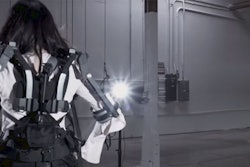When thinking of industrial robots, what often comes to mind are images of towering, several-ton metal behemoths working behind large safety enclosures. Warning lights, sensors and emergency stop buttons surround the robot as it goes about its daily tasks, all in an effort to keep its human coworkers safe.
However, a new kind of robot is starting to come to the forefront of the modern robotics discussion: the collaborative robot — or "cobot" — robots specifically designed to work side-by-side with humans to complete a job.
In September, IMPO had the opportunity to see these collaborative robots up close and in real-world situations at the second annual Robotiq User Conference (RUC) in Quebec City, Canada. Robotiq manufactures flexible robot grippers, sensors and vision systems with the goal of making automation easy, fast and accessible to global manufacturers and SMEs without the need of extensive technical knowledge, leading to a quick ROI.
On its website, Robotiq boasts to have freed hundreds of human hands from doing repetitive tasks, and in 10 years that number could grow to tens or hundreds of thousands.
The first day of the event consisted of inspiring keynotes discussing the exponential change and future of the manufacturing industry and how robotics will play a part.
Robotics And The Skills Gap
During her keynote address, Michelle Drew Rodriguez, Deloitte Manufacturing Leader, spoke about how automation and robotics could help address the skills gap.
“There is a talent shortage, there’s not enough people to do what needs to be done and I think robotics, and in fact collaborative robotics, can address that need,” Rodriguez says. Rodriguez stressed that utilizing robotics isn’t about replacing workers, it is about freeing up workers from doing repetitive, mundane tasks — that could easily be handled by robots.
“It’s about freeing up that intellectual power, that knowledge that they have to advance your operations,” Rodriguez says. “It’s taking that top talent and better serving your operations.”
Addressing the crowd at RUC 2017, Esben Østergaard, founder of Universal Robots and a visionary in the world of cobots, discussed the shift from traditional human-machine relationships. He said the relationship isn’t about man or machine, or man versus machine; it is about man and machine.
“We believe a robot is a tool that helps companies get more out of their employees rather than this machine behind a fence that takes jobs,” Østergaard says.
Universal Robots may not have been the ones to coin the term “cobots” but their goal to design a robot that was easily programmable, safe for employees to work with and easy to move around, redefined the robotics space.
Instead of looking at automation as something scary that could take away jobs, manufacturers should embrace the new technology as a way for employees to be more productive.
“Imagine if you had to put in screws on a table all day long with a traditional screwdriver, then someone came along with an electric screwdriver,” Østergaard says. “You could say it is taking away work from you, but no one would see it that way. They would see it as a tool — you can do more screws and it is more efficient. That's what we are trying to do with our robots.”
The Next Chapter At Robotiq
Robotiq got its start in 2008 as three friends on a mission.
“We were three guys out of university who just wanted to get into robotics and have fun doing it,” company CEO Samuel Bouchard says.
During that time, the Robotiq team hit the road with a newly designed pneumatic gripper ready for industrialization. After many “thanks, but no thanks” ends to sales calls, the team finally got their big break installing the gripper on industrial robots for a customer that dealt with a variety of different parts in production. Although the project was eventually canceled before completion, Bouchard said he learned a lot in the project.
“I realized I was lying the entire way, I was selling this to people as a time saver, a cost saver,” Bouchard says. “It took three days and three super-skilled engineers just to get the gripper to communicate with the robot. So, it was not plug and play at all. It was not time saving at all.”
It was back to the drawing board for Robotiq.
“We realized we had a solution to a problem, but it wasn’t a good fit,” Bouchard says. “It was like putting a square peg into a round hole.”
The issue, Bouchard said, was the robotic cell — the complete system that includes the robot, controller and other peripherals. It was too complex.
“So we decided that every product we make, each time it must be easier for the manufacturer to implement,” Bouchard says.
One way to make robotics easier to implement is to make the robotic cell less complex. At RUC, Bouchard announced the release of his book “Lean Robotics: A Guide to Making Robots Work in Your Factory,” which aims to simplify the deployment of a robotic cell to help manufacturing engineers get to production faster and save costs. In Lean Robotics, Bouchard says, manufacturers take control of their robot cell deployment projects.
“It’s not a book to promote our products, it’s a book to show people how to deploy robots more effectively on their factory floor,” Bouchard says. “The step-by-step guidelines detail how to deploy robots while taking every factory’s unique context into account. Best practices from the field also keep the user aligned with the principles of lean manufacturing, including waste reduction and scaling techniques.”
Challenge Accepted
At the event Robotiq also announced Blueprints — a free service to help design robotic cells; Skills — free, pre-built robotic programs made to extend the built-in capabilities of the robot with a broader variety of specialized tasks; and Insights — a web application that measures Universal Robots performance in real-time. On the second day of RUC 2017, attendees — comprised of Robotiq distributors and major end-users — were given the task of using the new Blueprints, Skills and Insights
and 40 Universal Robots collaborative robots to complete a 24-hour challenge as teams.
The eight teams — consisting of 175 participants from 22 countries — worked together to design five automated cells capable of transmission assembly using Lean Robotics principles and software tools. The teams also had to attract as many potential purchase orders as possible in a special sales challenge.
“Tomorrow morning when we stop the robots, the team that produces the most get nice trophies and the honor,” a Robotiq representative says while announcing the challenge. “Good luck and enjoy the day!”
The teams worked through the day — and some even into the wee-hours of the next morning — to get their five automated cells to work as effectively as possible.
Although always competitive, the atmosphere was one of excitement and camaraderie as participants rose to the occasion.
In the end, Team 4 (AKA The Latin Dream Team) walked away as the champions in both the sales and workshop challenges with 60 pumps assembled and 39 purchase orders.
"The team demonstrated great teamwork, great motivation and great application of Lean Robotics principles,” says Karine Simard, director of marketing at Robotiq. “Team 4 also produced the most parts and received the most purchase orders after a successful sales pitch challenge.”
Although not all the teams could win, all attendees came away with knowledge of the possibilities the Robotiq innovations can provide to manufacturers, big and small.























